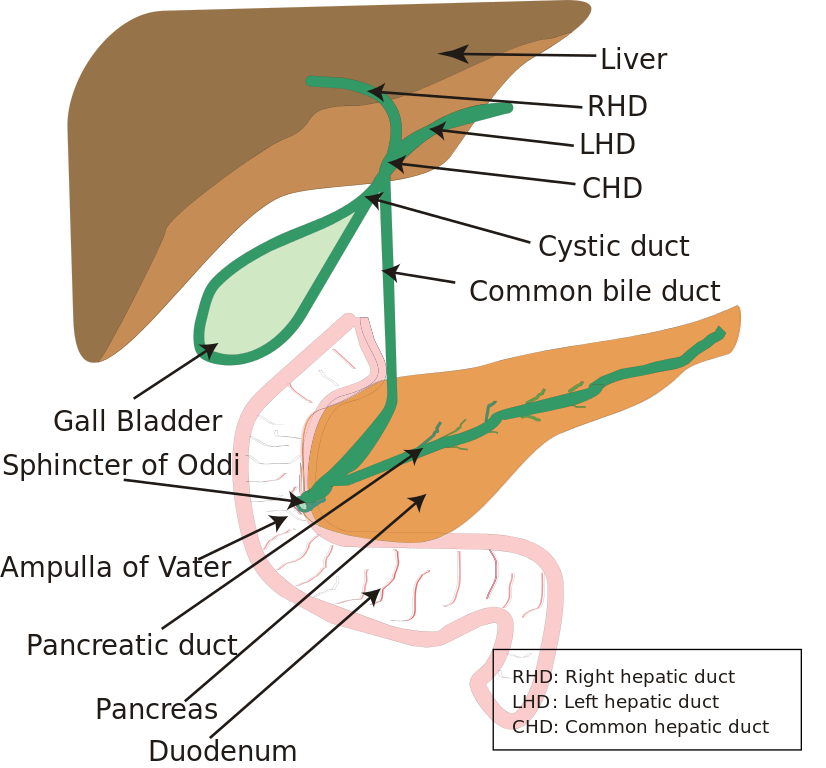[2]
Matton APM, de Vries Y, Burlage LC, van Rijn R, Fujiyoshi M, de Meijer VE, de Boer MT, de Kleine RHJ, Verkade HJ, Gouw ASH, Lisman T, Porte RJ. Biliary Bicarbonate, pH, and Glucose Are Suitable Biomarkers of Biliary Viability During Ex Situ Normothermic Machine Perfusion of Human Donor Livers. Transplantation. 2019 Jul:103(7):1405-1413. doi: 10.1097/TP.0000000000002500. Epub
[PubMed PMID: 30395120]
[3]
Boyer JL. Bile formation and secretion. Comprehensive Physiology. 2013 Jul:3(3):1035-78. doi: 10.1002/cphy.c120027. Epub
[PubMed PMID: 23897680]
[5]
Ballatori N, Li N, Fang F, Boyer JL, Christian WV, Hammond CL. OST alpha-OST beta: a key membrane transporter of bile acids and conjugated steroids. Frontiers in bioscience (Landmark edition). 2009 Jan 1:14(8):2829-44. doi: 10.2741/3416. Epub 2009 Jan 1
[PubMed PMID: 19273238]
[6]
Sundaram SS, Sokol RJ. The Multiple Facets of ABCB4 (MDR3) Deficiency. Current treatment options in gastroenterology. 2007 Dec:10(6):495-503
[PubMed PMID: 18221610]
[7]
Tabibian JH, Masyuk AI, Masyuk TV, O'Hara SP, LaRusso NF. Physiology of cholangiocytes. Comprehensive Physiology. 2013 Jan:3(1):541-65. doi: 10.1002/cphy.c120019. Epub
[PubMed PMID: 23720296]
[10]
Cowen AE, Campbell CB. Bile salt metabolism. I. The physiology of bile salts. Australian and New Zealand journal of medicine. 1977 Dec:7(6):579-86
[PubMed PMID: 274936]
[11]
Sannasiddappa TH, Lund PA, Clarke SR. In Vitro Antibacterial Activity of Unconjugated and Conjugated Bile Salts on Staphylococcus aureus. Frontiers in microbiology. 2017:8():1581. doi: 10.3389/fmicb.2017.01581. Epub 2017 Aug 23
[PubMed PMID: 28878747]
[12]
Roskams T, Desmet V. Embryology of extra- and intrahepatic bile ducts, the ductal plate. Anatomical record (Hoboken, N.J. : 2007). 2008 Jun:291(6):628-35. doi: 10.1002/ar.20710. Epub
[PubMed PMID: 18484608]
[13]
Ramesh Babu CS, Sharma M. Biliary tract anatomy and its relationship with venous drainage. Journal of clinical and experimental hepatology. 2014 Feb:4(Suppl 1):S18-26. doi: 10.1016/j.jceh.2013.05.002. Epub 2013 May 25
[PubMed PMID: 25755590]
[15]
Iluz-Freundlich D, Zhang M, Uhanova J, Minuk GY. The relative expression of hepatocellular and cholestatic liver enzymes in adult patients with liver disease. Annals of hepatology. 2020 Mar-Apr:19(2):204-208. doi: 10.1016/j.aohep.2019.08.004. Epub 2019 Sep 20
[PubMed PMID: 31628070]
[34]
Vij M, Rela M. Biliary atresia: pathology, etiology and pathogenesis. Future science OA. 2020 Mar 17:6(5):FSO466. doi: 10.2144/fsoa-2019-0153. Epub 2020 Mar 17
[PubMed PMID: 32518681]
[35]
McNicoll CF, Pastorino A, Farooq U, Froehlich MJ, St Hill CR. Choledocholithiasis. StatPearls. 2024 Jan:():
[PubMed PMID: 28722990]
[37]
Oelkers P, Kirby LC, Heubi JE, Dawson PA. Primary bile acid malabsorption caused by mutations in the ileal sodium-dependent bile acid transporter gene (SLC10A2). The Journal of clinical investigation. 1997 Apr 15:99(8):1880-7
[PubMed PMID: 9109432]
[39]
Nisa AU, Ahmad Z. Dubin-Johnson syndrome. Journal of the College of Physicians and Surgeons--Pakistan : JCPSP. 2008 Mar:18(3):188-9
[PubMed PMID: 18460254]

